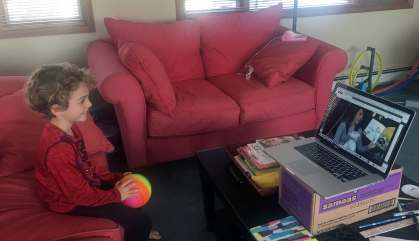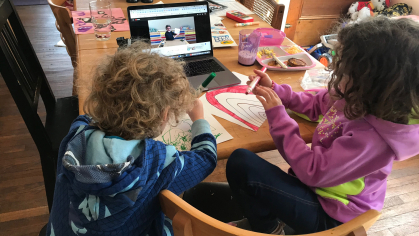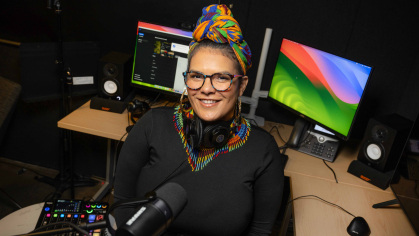Tips for Working Parents Turned Teachers
GG Weisenfeld and Yana Rodgers offer advice to help homebound parents balance work duties while educating their children

Parents across the country have been thrust into the role of homeschool teacher in the face of a global pandemic that has turned the American way of life upside down.
Gone is the morning race out the door to get the kids to school and parents to work. Now, the challenge many working parents face is structuring the day to make sure their children are still learning while also trying to do their jobs from home. One comforting fact is that we are not alone in this difficult situation.
Rutgers Today talked to GG Weisenfeld from the National Institute for Early Education Research for advice on how to help our children with their home education and Yana Rodgers from the School of Management and Labor Relations’ Center for Women and Work for tips on how parents can balance their work-related responsibilities with their expanded domestic roles in this unprecedented time.
Here are some tips for homeschooling:
What advice do you have for parents struggling with children who aren’t as cooperative learning at home as they might be in a classroom? For example, my 4-year-old keeps telling me I’m not doing things the exact way his preschool teachers do and refuses to participate in any kind of educational activity.
Weisenfeld: Just like we are stressed, so are our children. One of the ways children demonstrate their anxiousness is by being uncooperative. We want children to feel safe. We can do this by being realistic and consistent in our expectations (younger children have shorter attention spans of 10-15 minutes when working on tasks) and remaining calm ourselves.
Remind your preschooler that home is different. One way to start the conversation is to record it: What are some things that are the same at home as at school? What things are different? What can we do differently at home that reminds us of preschool? Keep adding to the lists. Encourage your child to be part of the process. This is also a good early literacy activity – connecting oral language to written language.
Is it possible for parents to replicate the experience of going to school or should we be aiming for something different at home?
Weisenfeld: Change is hard. It is typically best to try and help your child experience his or her day at school at home as best as you can. One of the most important things can you do is follow your child’s regular school schedule. Some programs may have already shared this information with you, or it may be available on their websites. If not, as a family you can create one through websites like Macaroni Kid. For younger children, include visuals. Try to replicate activities your child enjoys with materials you have at home.
Do you have advice for parents who never saw themselves in the role of teacher?
Weisenfeld: Learning not only happens at school but also at home because parents are teachers. Everything you do sets an example for your child. This is an opportunity for you to create high-quality educational experiences for your children while doing ordinary things, such as making meals. There are many resources online to support you in identifying ideas, but not all are created equally. Try to limit screen time and find activities that encourage creativity, use multiple materials, and allow for sensory play.
Common Sense Media provides parent and child reviews of websites, games and apps, as well as reviewed COVID-19 resources. Both NYC and Boston have created resources for preschool families. In addition to museums that offer virtual tours: 20 Virtual Field Trips to Take with Your Kids; Cincinnati Zoo & Botanical Garden brings the zoo to you! and Smithsonian Education and Learning Lab.

My 4-year-old perked up this morning when he had the chance to video chat with a friend. He played his piano while his friend was drumming on a box. It felt like such a parenting win. What tips do you have for helping children deal with the social isolation of being home and away from their friends?
Weisenfeld: Thank goodness for our ability to video chat. Young children might not have an adult conversation with their friends, but they could sing a song together or share silly dress-up outfits. Helping with the content, and keeping the conversation short, might make it more successful. This is also a great time to connect with grandparents and other family members.
When it’s time to go to work:
Working from home with children is one thing. Working from home while doubling as a teacher – to multiple children – is entirely another. What are realistic expectations for employers of working parents and employees teaching and working from home?
Rodgers: The key word is here is expectations, both for employers as well as employees. I think expectations of productivity should be relaxed by everybody because productivity will decline.
What policies can/should be enacted right now by the government or employers to support working/homeschooling parents?
Rodgers: The second federal COVID-19 relief package passed March 18 includes – for the first time – paid family and medical leave during this crisis to care for a sick or at-risk family member or yourself. This emergency paid leave policy also applies to employees who need to care for children whose schools or daycare facilities are closed. Some states, including New Jersey, have six weeks of paid family leave to care for a newborn, newly adopted child, or a sick family member. But that does not cover parents who take time off to homeschool children. The new federal emergency legislation helps to cover this gap, but not all workers are eligible.
This is the time to discuss flexible working arrangements, such as job sharing. That could free up some time during this crisis for working parents to devote to schooling children. Many workplaces have developed training programs and policies around online work and telecommuting. I hope the same would happen with family-friendly policies such as job sharing and flextime because we will see it can be done in a productive way.
Evidence shows women already contort their daily schedules more than their male counterparts to balance parenting and working. What can be done to address this gap in this new reality?
Rodgers: COVID-19 is not only a major economic and health shock. It’s also going to be a major shock to social norms as well. Men who will now be home more, will see the work that has to be done. It will change attitudes that domestic work is women’s work. Men and women will better understand that domestic work is work that needs to get done, and both parents need to do it.
– Lisa Intrabartola and Andrea Alexander


